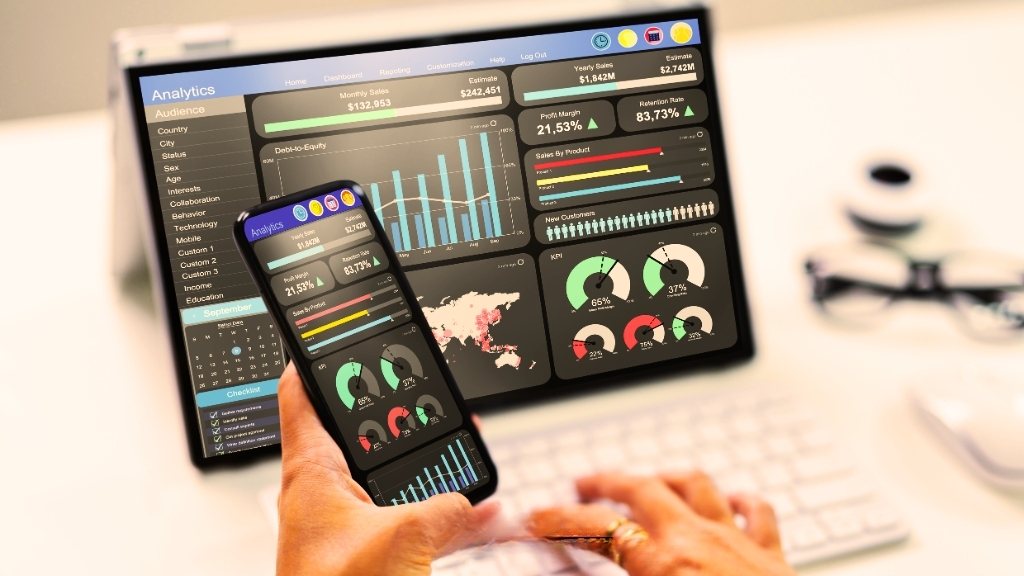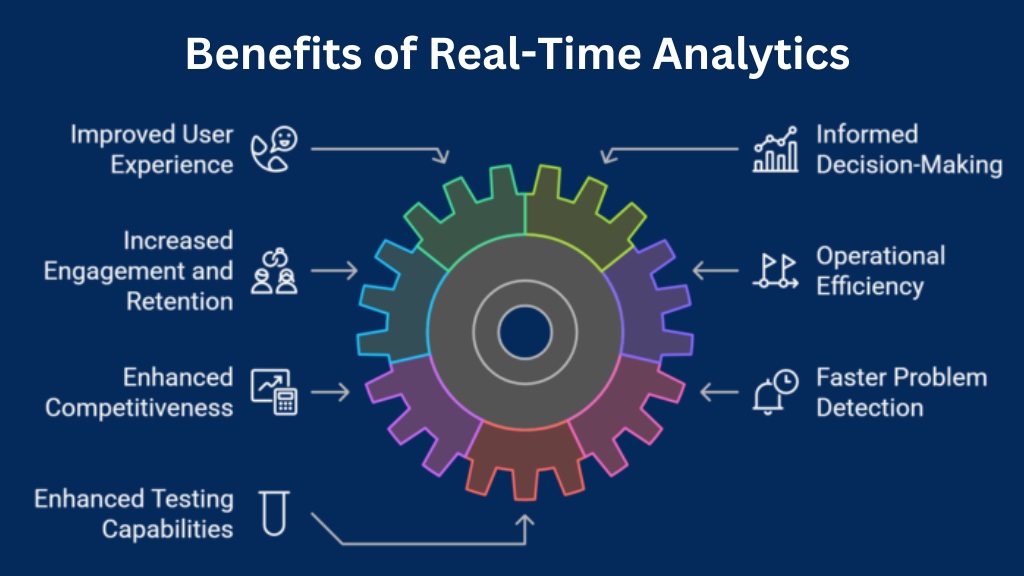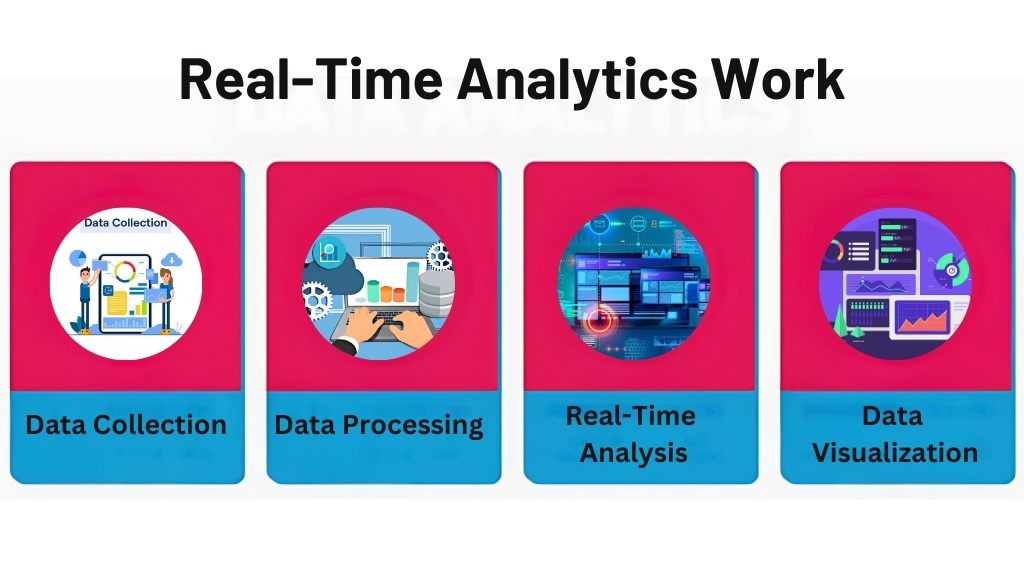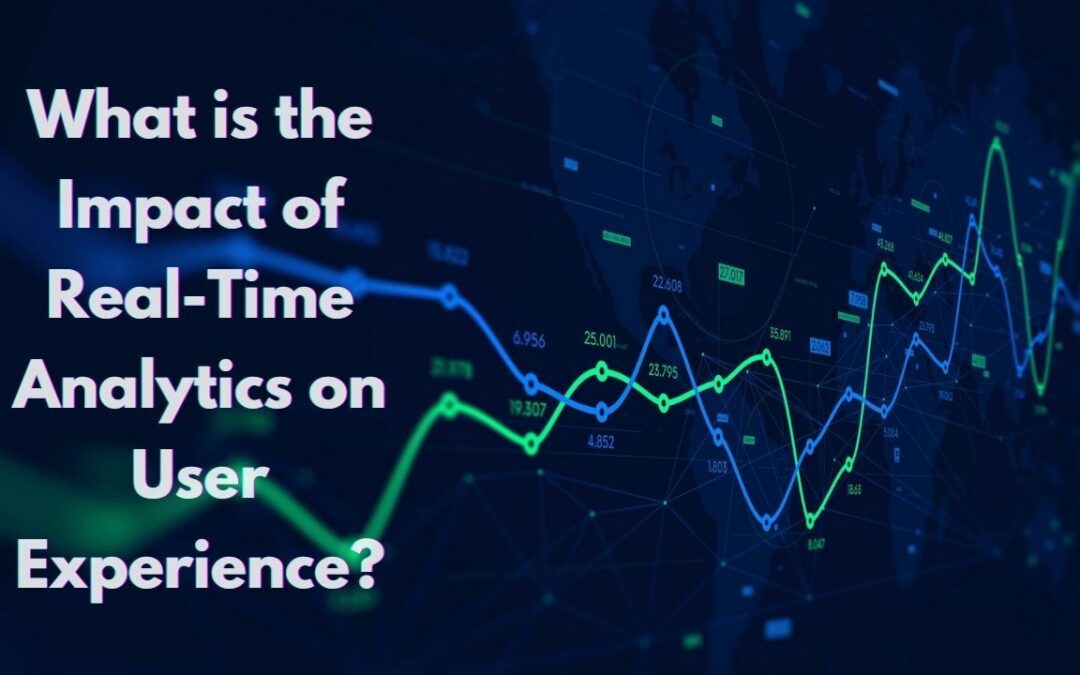Real-time analytics empowers organizations to monitor, evaluate, analyze and react to data as it is generated, providing immediate insights into user behavior, content performance, and system health. Unlike conventional analytics, which often relies on historical data and provides insights after a delay, real-time analytics can process data within milliseconds of the data being created. This post will evaluate the importance of real-time analytics, its advantages, and the underlying mechanisms.
What is Real-Time Data Analytics?

Real-time, streaming analytics helps organizations process real-time data. Instead of storing and evaluating data in batches, companies that conduct real-time data analysis generate insights instantly, while the data is being streamed.
Usually, data analysis occurs after data acquisition and storage. Insights were only available after the storage process. Real-time data analysis helps change this by enabling businesses to react faster and make more accurate decisions.
Why is Real-Time Data Analytics Important?
Real-time analytics involves collecting and analyzing data as it is generated, which allows organizations to make immediate insights. Conventional batch analytics tools often work in contrast to this by processing the data with delays. The delay in accessing and analyzing the data can be detrimental to the decision-making process and be costly for companies impacting time, resources and finances.
Generally, data that is streamed is more valuable. Companies understand that most data has a limited shelf life, hence the earlier they can translate data into actionable insights, the more valuable that data will be.
Are you considering the commercial advantages of streaming analytics? Real-time user experience data analytics empower businesses to:
- Anticipate consumer actions.
- Address the technical issues with standard data batch processing.
- Increase processing speed at scale.
- Improve decision making.
- Proactively maximise client satisfaction.
- Reduce response times.
- Develop more intelligent products and services.
- Automate and improve business operations.
Benefits of Real-Time Analytics

Real-time analytics can transform how companies operate and make decisions. Real-time analytics enables companies to be more agile, responsive, and customer-centric. These benefits extend beyond operational improvement, and can help define corporate strategy and competitive positioning.
Improved User Experience
Real-time analytics ensures optimal performance of content and applications through continuous monitoring and optimization utilizing user experience analytics, leading to improved user experience and retention.
Informed Decision-Making
Real-time insights empower companies to make swift, data-driven decisions, whether it’s changing a video streaming plan, maximizing app performance, or reacting to new trends.
Increased Engagement and Retention
Understanding user behavior in real time helps companies to customize content and user experiences according to their preferences, thereby enhancing user engagement and reducing churn. This is critical as users today have an abundance of choices and low tolerance when it comes to system inefficiencies and poor performance.
Operational Efficiency
Real-time analytics ensures efficient allocation of resources and helps to find and fix problems as they arise, minimising downtime. This proactive strategy reduces disruptions and improves operational efficiency.
Enhanced Competitiveness
The ability to quickly identify patterns and performance criteria gives companies a competitive advantage, enabling them to make data-driven decisions faster than competitors who are dependent on historical data alone.
The ability to effectively utilize real time data can distinguish your company as a market leader among your competitors.
Faster detection of workflow problems
Companies that operate in time sensitive industries, such as manufacturing or retail, are integrating data streams with event-processing systems. This allows them to identify workflow issues proactively before they negatively impact employees or customers.
For instance, the system can alert an agent when Infrastructure Monitoring a sophisticated system at a customer site indicates a potential breakdown. Certain industrial and power-generation systems go further, using real-time sensor data showing anomalies to automatically order components and send a maintenance team.
Such systems may leverage IoT data, data management systems, and even long-term operational data analysis. Machine learning algorithms analyze minute changes in fast-moving data streams to recommend process improvements over time.
Enhanced testing capabilities
Proven use cases for real-time data and automated responses emerge from software testing and IT management. Real-time analytics integrated into a strong software testing system can effectively detect API errors, identify and log data errors, and even highlight user interface problems. Real-time analytics can also assist with maintenance of long, labor-intensive testing scripts by automating validation processes, reducing the reliance of manual validation techniques.
How Does Real-Time Analytics Work?

Real-time analytics involves a set of connected procedures that convert raw data into insights. Understanding these mechanisms helps organizations maximize their user experience analytics tools.
Data Collection
Real-time analytics relies on continuous data collection from multiple sources. Data collecting starts the moment a user starts interacting with the system.
Real-time analytics tools gather a broad spectrum of data points including:
- Playback Metrics: Start timings, buffering events, resolution changes, and general playback quality.
- Engagement Metrics: Viewer interactions such as clicks, pauses, rewinds, and fast forwards.
- Performance Metrics (for video ads): Impressions, click-through rates, and conversion rates.
- Mobile and Online Application Data: Gathered through user interactions with the app, including clicks, scrolls, and navigation across several sections. This includes:
- User Interaction Metrics: Navigation pathways, swipes, taps, scrolling.
- Performance Metrics: Load times, API response times, and error occurrence.
- Behavioral Metrics: User paths, workshop lengths, and drop-off locations.
Data collection is facilitated through embedded scripts or software development kits (SDKs) housed within the app or video platform. These programs transfer real-time data automatically to a central analytics server.
Data Processing
Once gathered, raw data requires manipulation and transformation in order to generate insightful analysis. This involves several phases:
- Data Ingestion: Data is entered into a real-time analytics platform where it is instantly accessible for processing. These systems use distributed processing systems that can handle large volumes of data at low latency, to ensure the analysis occurs nearly instantaneously.
- Data Aggregation: Real-time analytics frequently aggregates data to produce meaningful measurements and summaries. For example, the platform might combine clicks by user sessions, geographic regions, or specific time periods instead of examining every single click separately.
- Data Standardization & Enrichment: Raw data is then standardized to guarantee consistency and enriched with additional context. IP addresses, for instance, might be converted into geographical coordinates or device types could be identified from user agent strings.
- Stream Processing: Real-time data processing is commonly accomplished with stream processing engines. These engines offer sophisticated event processing (CEP), therefore enabling a system to identify trends, anomalies, or particular conditions demanding quick response. For applications like video streaming analytics-where every millisecond counts-stream processing engines can handle enormous volumes of data with low latency to deliver seamless user experience.
Real-Time Analysis
Real-time analytics primarily focuses on the immediate analysis of data. Teams that practice rapid analysis can react quickly to emerging trends, issues, and user behavior patterns. By using cutting-edge algorithms and machine learning techniques, this technique can find trends and anomalies possibly that may be overlooked by more conventional analytics tools. For companies functioning in fast-paced digital environments–particularly streaming, retail, betting, and travel sectors–where user experience can change at any moment-this is absolutely vital. Real-time analysis can be implemented in various ways:
- Anomaly Detection: Real-time analytics systems continuously monitor data constantly for anomalies. For example, during a Black Friday sale, an unanticipated increase in payment failures could point to a third-party payment gateway problem requiring immediate attention.
- Trend Analysis: Real-time analytics can identify developing trends including a sudden surge in the popularity of a given product or feature within an app.
- Behavioral Analysis: Real-time data lets one study user behavior as it occurs. For instance, there could be a content or functionality issue if users frequently leave a film or app at a designated point.
- Performance Monitoring: Real-time analytics measures performance indicators including load times, error rates, and server response times, providing instant alerts if performance deteriorates.
Data Visualization
- Live Dashboards: Real-time dashboards provide updates regularly which allows stakeholders to closely monitor application Performance. These dashboards include graphs, charts, heat maps, and other visualizations that illustrate user interactions, performance measures, and other critical data.
- Custom Alerts: Custom alerting systems can be configured to trigger according to specific criteria, such as when an app’s error rate increases or when login processing time exceeds a predefined threshold.
- Drill-Down Capabilities: Advanced real-time analytics systems enable users to investigate specific data points for deeper insights. For example, a surge in app crashes could be linked to a specific device type or operating system version.
Dashboards on real-time analytics systems sometimes show live data. Effective data visualization makes complex datasets easy to understand, providing quick, clear, actionable insights.
Conclusion
Real-time analytics provides instantaneous information on user behavior, preferences, and interactions, significantly improving user experience. This enables organizations to adapt content, customize offerings, and maximize performance. More relevant, timely, and seamless interactions improve user satisfaction and engagement. Real-time data allows companies to rapidly address issues, answer questions, and predict consumer behaviour, and in the process building client loyalty. Ultimately, real-time analytics is a major driver in raising customer satisfaction and promoting long-term success, as it empowers companies to build intuitive, responsive, and customized experiences.
FAQs
What is Real Time Analytics?
Real-time analytics enables companies to act on data shortly after it is generated. Real time app analytics provide responses within a few seconds. Their low latency and high processing speed allow for the management of large volumes of data. For example, real-time big data analytics can guide trading decisions by leveraging data in financial databases.
Benefit of Real Time Analytics?
- Customizable and interactive analytics.
- Live dashboarding.
- Draw insights from behavioral monitoring.
- Implement changes promptly based on requirements.
- Machine learning.
Difference between Real-Time Analytics and Streaming Analytics
While streaming analytics concentrates on handling continuous data flows from many sources, real-time analytics gives immediate data processing within limited time top priority to facilitate fast decision-making. The main difference is that whilst streaming analytics is defined by its method of managing infinite data streams, real-time analytics is defined by its reaction time needs.
What is a Streaming Database?
Designed especially to process vast volumes of real-time streaming data, a streaming database is a kind of database. Unlike conventional databases, which save data in batches prior to processing, a streaming database analyzes data as soon as it is produced, therefore enabling real-time insights. A streaming database may store data and answer user data access requests unlike conventional stream processing engines that do not retain data.

